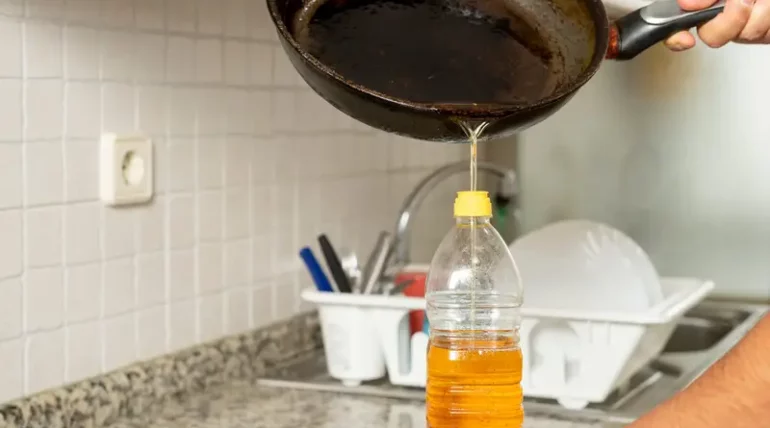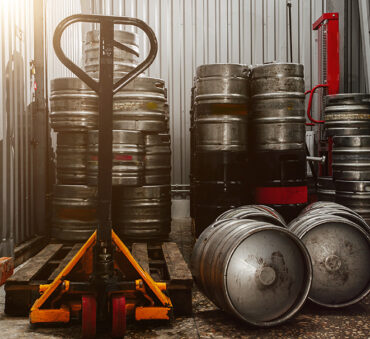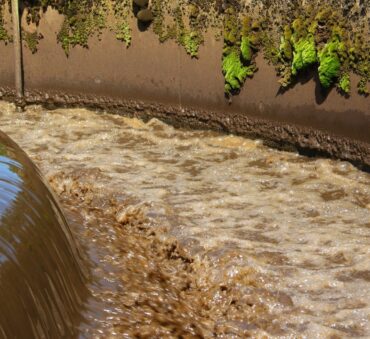In the realm of culinary arts, the advent of the modern food industry has revolutionized our kitchens and dining experiences. From the convenience of pre-packaged meals to the availability of a wide array of ingredients from around the world, our culinary horizons have expanded like never before. However, this progress has not come without challenges. One of the most pressing issues we face today is the proper disposal of waste, particularly cooking oil.
Cooking oil, an essential component of many dishes, has become a ubiquitous part of our culinary culture. However, similarly to fat and grease disposal, it’s often mishandled, especially at the household level.
Key Takeaways
- Cooking oil, if not disposed of correctly, can cause significant environmental harm, including water contamination and damage to local wildlife. It can also lead to blocked sewage systems and expensive infrastructure maintenance.
- There are several methods for recycling used cooking oil, including composting, using it as a slow-release fertilizer, soap making, and conversion into biodiesel.
- Cooking oil waste can take several forms, including burned, expired, contaminated, and rancid oil. Each of these poses unique challenges and risks to both human health and the environment.
- The process of managing used cooking oil involves several stages, including collection, storage, transportation, treatment/processing, recycling, and disposal. Each stage requires careful handling and adherence to regulations to ensure safety and environmental protection.
- Companies like Shapiro play a crucial role in managing used cooking oil. They provide services that ensure the oil is collected, processed, and recycled or disposed of in a manner that is both legally compliant and environmentally friendly.
So, how to dispose of cooking oil? Is it safe to pour it down the drain? And how can we manage it the right way?
We’ll cover all this and more below.
Cooking Oil Disposal: Why Does It Matter?
As we delve deeper into the complexities of cooking oil waste management, it becomes evident that the repercussions permeate various aspects of our lives and society:
- Environmental Damage: One of the most significant consequences of not correctly disposing of cooking oil is the detrimental effect it has on the environment. It can contaminate water sources, harm wildlife, and contribute to pollution.
- Infrastructure Maintenance: When oil is disposed of down drains, it can solidify and clog up systems, leading to expensive repairs and maintenance. This is a common issue in both residential and commercial settings.
Health Considerations: Left or mismanaged, the oil can become a breeding ground for bacteria and other harmful microorganisms, posing a risk to public health. - Legal Compliance: In many jurisdictions, there are strict regulations regarding the disposal of used cooking oil in industrial settings. Non-compliance can lead to hefty fines and legal repercussions.
- Sewage System Integrity: Pouring oil down toilets may lead to blockages in the sewage system. Over time, these blockages can cause serious damage, leading to costly repairs and potential health hazards due to sewage backups.
- Economic Consequences: The costs associated with the damage caused by incorrect disposal methods can be substantial. These include expenses related to repairing damaged infrastructure, cleaning contaminated areas, and health care costs associated with exposure to harmful substances.
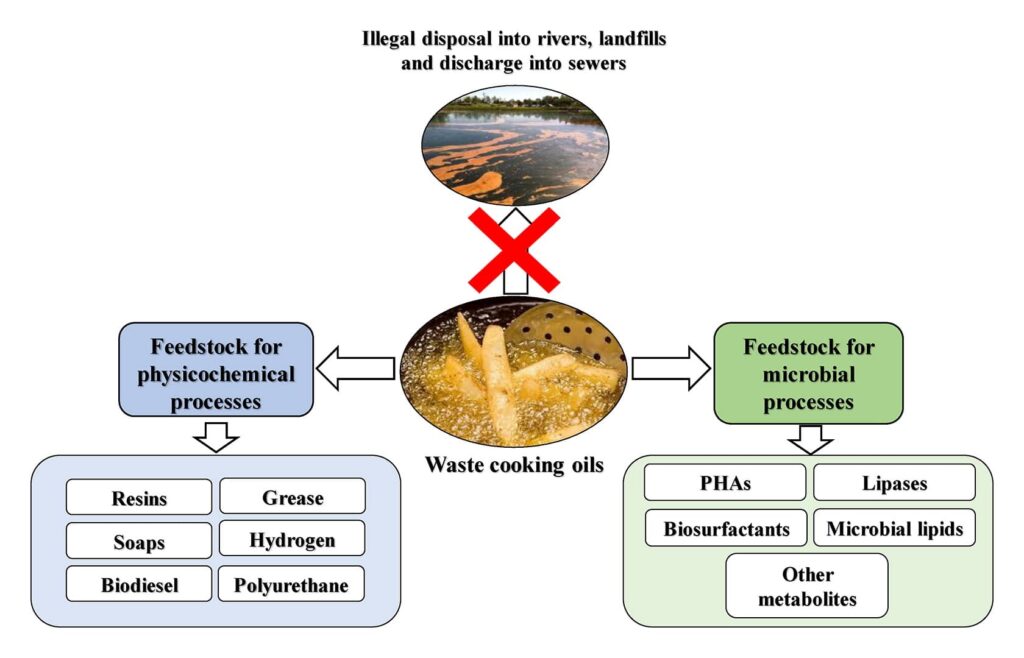
Cooking Oil Recycling Techniques
You might be wondering, “What can I do with used cooking oil?” or “Are there any uses for used cooking oil?” The answer is yes, and there are several techniques for recycling cooking oil.
Compost cooking oil
Food waste such as cooking oil can be composted to create a nutrient-rich soil conditioner. By mixing small amounts with other compostable materials, the oil can be broken down by microorganisms in the compost pile. It’s essential to use the oil sparingly in compost, as too much can create a greasy layer that inhibits the composting process. The composted oil adds valuable carbon to the soil, improving its texture and fertility.
Used cooking oil as fertilizer
Another innovative way is by using it as a slow-release fertilizer. The oil is processed and combined with other materials to create a fertilizer that releases nutrients slowly over time. This can be particularly beneficial for plants that need a steady supply of nutrients. The use of used cooking oil as a fertilizer not only provides a sustainable way to dispose of waste oil but also contributes to the health and growth of plants.
Used cooking oil for soap making
Turning used cooking oil into soap is a traditional and effective recycling method. Through a process known as saponification, the triglycerides in the oil react with a strong alkali, such as sodium hydroxide, to form soap. This method not only repurposes the waste oil but also results in a biodegradable product that can replace conventional soaps. The process can be tailored to create various types of soap, depending on the oil and other ingredients used.
Used cooking oil to make biodiesel
Perhaps one of the most well-known uses is in the production of biodiesel. Many specialist recycling companies collect the used oil, clean it, and then process it into biodiesel, a renewable source of energy that can be used in diesel engines. The process involves a chemical reaction that transforms the oil into biodiesel and glycerin, a byproduct that can be used in other industries. This method of recycling not only reduces waste but also helps to decrease reliance on fossil fuels.
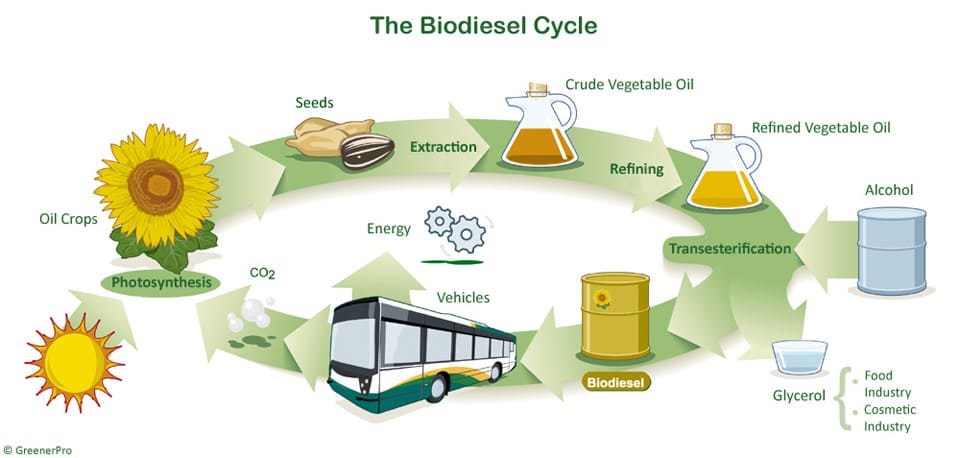
Common Waste Cooking Oil Sources
There are various industries that we can consider as a direct source of waste cooking oil. We can mention 3 main sources:
- Restaurants: they generate a significant amount of used cooking oil, often from deep-frying and grilling activities. This oil, once it has reached its heat tolerance limit and starts to break down, becomes a disposable waste product.
- Households: in our homes, we often overlook the importance of properly disposing of used or expired cooking oil. Once it has been used multiple times or has been left sitting for a while, it will need to be properly disposed of
- Industrial: on this scale, cooking oil can become waste due to factors such as improper storage, transportation mishaps, distribution errors, or manufacturing quality control issues. This waste can be substantial and poses both environmental and health risks if not managed correctly. Industrial waste oil can contaminate water sources and soil, and if used in food production, it can lead to substandard products that may be harmful to consumers.
Waste Cooking Oil Examples
- Burned Cooking Oil: When cooking oil is subjected to high temperatures, it can burn and produce harmful substances. These substances, such as acrolein, can cause respiratory irritation and eye problems. It’s crucial to manage this waste effectively to prevent health risks and environmental damage.
- Expired Cooking Oil: Cooking oil has a shelf life, and once it’s expired, it can become rancid and develop harmful bacteria. Consuming such oil can lead to food poisoning and other health issues. From an environmental perspective, expired oil can cause harm if it enters the ecosystem.
- Contaminated Cooking Oil: Cooking oil can become contaminated through various means, such as exposure to bacteria, cross-contamination with other substances, or contact with unclean utensils or containers. Contaminated oil poses a significant health risk and should be disposed of immediately and handled as hazardous liquid waste to prevent foodborne illnesses.
- Old, Stale, or Rancid Cooking Oil: Over time, cooking oil can become stale or rancid due to oxidation. This process changes the oil’s chemical structure, making it harmful to consume as it can lead to digestive issues and other health problems. Like other types of waste cooking oil, it should be disposed of properly to prevent health risks and environmental harm.
How to Dispose of Cooking Oil In An Environmentally Friendly Way
1. Collection
The initial phase of cooking oil management is the collection process. This involves gathering waste cooking oil from various sources, such as restaurants, food processing industries, and households. Specialized companies like Shapiro often perform this task, ensuring that the oil is safely and efficiently collected.
2. Storage
The oil is stored in designated containers that are designed to prevent leakage and contamination, ensuring the oil is kept in a controlled environment. It’s crucial to maintain the integrity of the oil during this stage, as it directly impacts the subsequent processes.
3. Transportation
The next stage involves the transportation of the stored oil to a processing facility. This is done using specialized vehicles equipped with cooking oil containers that are designed to handle the weight and viscosity of the oil. The transportation process must adhere to strict regulations to prevent spills and ensure safety.
4. Treatment and processing
Upon arrival at the processing facility, the oil undergoes a treatment process involving several steps, including filtration to remove impurities and heating to eliminate water content. The goal is to prepare the oil for its next life, whether that be as biodiesel, animal feed, or another application.
5. Recycling
The clean oil is then processed through a method called transesterification, where it is heated and mixed with an alcohol, usually methanol, and a catalyst, typically sodium or potassium hydroxide. This reaction breaks down the oil molecules and forms biodiesel and glycerin. The biodiesel is separated, washed, and polished for use as a renewable energy source, while the glycerin byproduct can be used in the production of soaps and other products.
6. Disposal
The final stage in the process is disposal. While the majority of the treated oil is recycled, there may be residual waste that needs to be disposed of. This waste, which can include solid residues or wastewater, is disposed of in accordance with environmental regulations to minimize any potential harm to the environment.
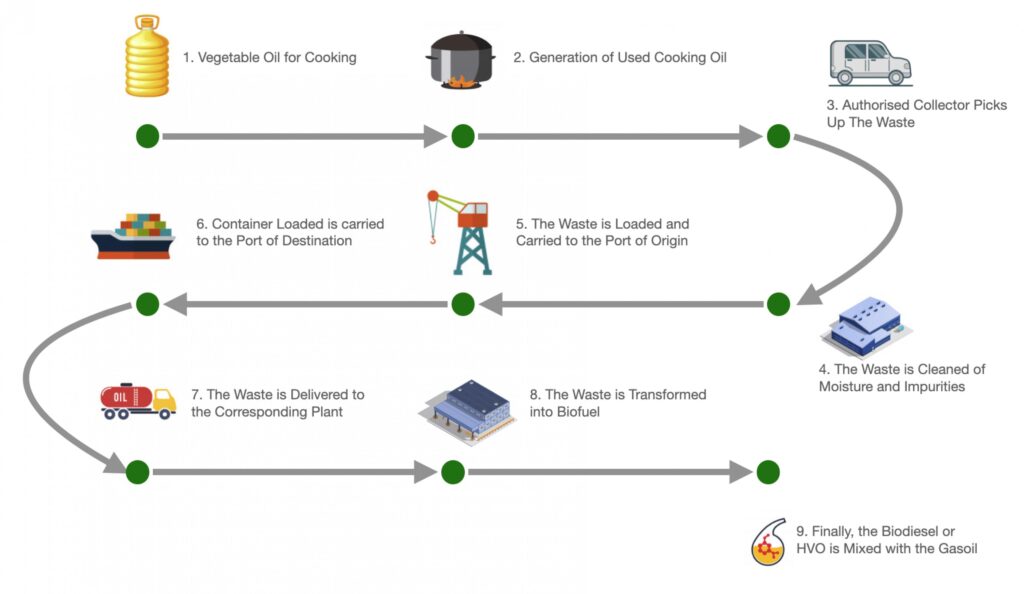
How can cooking oil recycling companies help?
If grossly managed, used oil could even go as far as being classified as hazardous liquid waste due to its potential to cause significant environmental harm. Conversely, cutting corners with liquid waste management (such as pouring it down drains or discarding it in regular trash) can lead to dire consequences. For example you have blocked sewage systems, water contamination, and detrimental effects on local wildlife. Yet, this is not only an environmental problem but also illegal for businesses or anyone dealing with cooking oil on a large scale. And should businesses be found guilty of such practices, they can face severe penalties, including substantial fines and lawsuits.
This is where commercial cooking oil disposal companies like Shapiro provide a crucial service. With our expertise in organic waste management and liquid waste disposal, you can be sure that you’re in good hands . We ensure that the used cooking oil is collected, processed, and recycled or disposed of in a manner that is both legally compliant and environmentally friendly, shielding businesses from potential legal issues and contributing to a more sustainable future.
Conclusion
The proper disposal of cooking oil is a critical aspect of waste management that has far-reaching implications for our environment, infrastructure, and public health. It’s a complex process that requires careful handling at every stage, from collection to disposal. Mismanagement of this process can lead to significant environmental damage and severe legal repercussions. Therefore, it’s essential for businesses, particularly those in the food industry, to partner with professionals like Shapiro.
Frequently Asked Questions
Just like any other organic substance, cooking oil can go rancid over time. This is due to exposure to heat, light, and oxygen. It’s always best to store your oil in a cool, dark place and use it within its best-by date.
Yes, cooking oil does expire. Over time, exposure to air, light, and heat can cause it to become rancid. Always check the expiration date on the bottle and store it properly to extend its shelf life.
Used cooking oil should be stored in a clean, airtight container in a cool, dark place. It’s important to strain out any food particles before storage to prevent them from spoiling the oil.
Yes, you can reuse cooking oil. However, it’s important to filter it after each use to remove any food particles. Repeated heating and cooling can degrade the oil over time, so it’s best to reuse it only a few times.
Unopened cooking oil can last up to two years from the date it was manufactured. Once opened, it’s best to use it within six months for optimal quality. However, the shelf life can vary depending on the type of oil and how it’s stored.
Yes, cooking oil is flammable. If it’s heated to its smoke point, it can catch fire. Always monitor cooking oil when heating it and never leave it unattended.
Used cooking oil is not classified as hazardous waste, but it should not be poured down the drain as it can clog pipes and harm the environment.
To filter cooking oil, let it cool, then pour it through a fine sieve or cheesecloth to remove any food particles.
While it’s technically possible, it’s not recommended to use cooking oil as a lubricant for machinery or tools, as it can gum up and attract dirt.
To solidify cooking oil, you can mix it with an absorbent material like cat litter or coffee grounds, then place it in a sealed container before disposing of it in the trash.
Ideally, used cooking oil should be disposed of at designated recycling centers or facilities that accept used cooking oil, ensuring it is handled in an environmentally friendly manner. However, if this is not possible, it should be poured into a non-biodegradable, sealable container and disposed of with regular trash.
Technically, yes, cooking oil is biodegradable. However, it can cause problems in the environment if not disposed of properly.
The value of used cooking oil can vary, but it’s often sold for use in biodiesel production. The price can depend on the quality and quantity of the oil.
Used cooking oil is often purchased by waste management companies, biodiesel manufacturers, and certain recycling organizations, all of whom recognize its potential for reuse and conversion into sustainable energy sources.
Yes, it’s safe to reuse cooking oil a few times if it’s properly filtered and stored. However, each time it’s heated, it degrades slightly, so it’s best to limit reuse.
No, you should never flush cooking oil down the toilet. It can solidify and clog pipes, leading to expensive repairs.
While some types of cooking oil can be converted into biodiesel fuel, you should never pour cooking oil directly into your car’s fuel or oil tank. It needs to be processed first.
Many restaurants typically contract with specialized waste management companies that collect and recycle used cooking oil, turning it into biodiesel or other environmentally friendly products, ensuring a responsible and sustainable disposal process.
Baily Ramsey, an accomplished marketing specialist, brings a unique blend of anthropological insight and marketing finesse to the digital landscape. Specializing in educational content creation, she creates content for various industries, with a particular interest in environmental initiatives.
